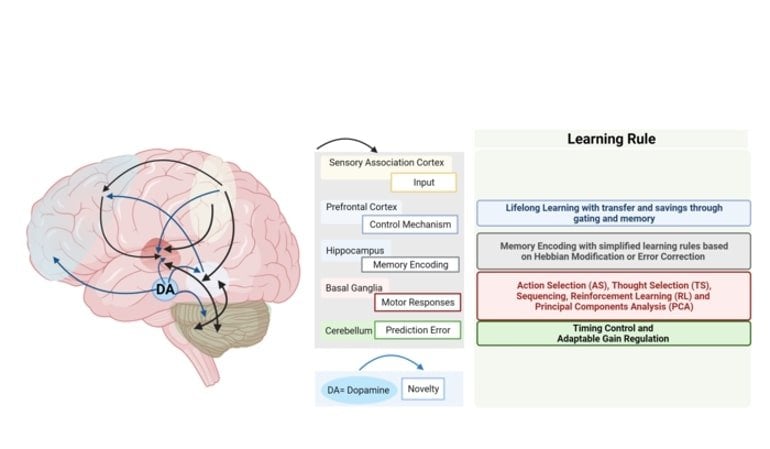Summary: Researchers propose a new framework for three seemingly unconnected forms of creativity.
Source: Jacobs University
Creativity is understood as the creation of novel, useful and surprising solutions.
The researchers argue that the associated cognitive processes, such as the ability to abstract, improvise, or think divergently, involve different brain areas that are interconnected. These areas include the cerebellum, hippocampus, prefrontal cortex, and basal ganglia.
Different areas are activated depending on the type of creativity. The similarities and differences between these types of creativity and their neuronal circuits are described by the model with the help of algorithms.
Dopamine plays an essential role as a critical modulator for controlling and optimizing creative neural pathways.
With this proposed neural network model, the scientists, for the first time, provide a unified framework for seemingly three different forms of creativity.
“With this starting point, we hope to thoroughly contribute to a better understanding of the underlying neuronal mechanisms,” said Khalil.

“The more we know about these mechanisms, the more specifically we can promote creativity and possibly contribute as promising interventions for people with relevant disturbed brain areas.”
With their model, the scientists also want to initiate a discussion about neurobiology and creativity, adds Radwa Khalil. An associate professor, Ahmed A. Moustafa, from the University of Johannesburg and the School of Psychology at Bond University in Australia, are also involved in the research.
As a visiting Professor of the German Academic Exchange Service (DAAD), Moustafa will continue his creativity research this summer at Jacobs University, hosted and led by Professor Dr. Ben Godde Professor of Neuroscience at Jacobs University Bremen.
About this creativity and neuroscience research news
Author: Heiko Lammers
Source: Jacobs University
Contact: Heiko Lammers – Jacobs University
Image: The image is credited to Jacobs University
Original Research: Open access.
“A neurocomputational model of creative processes” by Radwa Khalil et al. Neuroscience
Abstract
A neurocomputational model of creative processes
Creativity is associated with finding novel, surprising, and useful solutions. We argue that creative cognitive processes, divergent thinking, abstraction, and improvisation are constructed on different novelty-based processes.
The prefrontal cortex plays a role in creative ideation by providing a control mechanism. Moreover, thinking about novel solutions activates the distant or loosely connected neurons of a semantic network that involves the hippocampus.
Novelty can also be interpreted as different combinations of earlier learned processes, such as the motor sequencing mechanism of the basal ganglia. In addition, the cerebellum is responsible for the precise control of movements, which is particularly important in improvisation.
Our neurocomputational perspective is based on three creative processes centered on novelty seeking, subserved by the prefrontal cortex, hippocampus, cerebellum, basal ganglia, and dopamine.
The algorithmic implementation of our model would enable us to describe commonalities and differences between these creative processes based on the proposed neural circuitry.
Given that most previous studies have mainly provided theoretical and conceptual models of creativity, this article presents the first brain-inspired neural network model of creative cognition.







